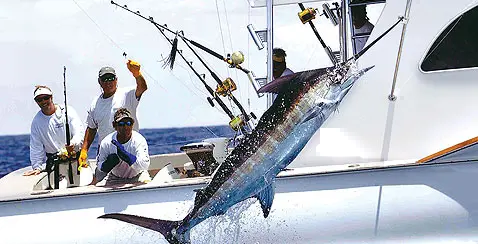If you are new to deep sea fishing, there are some important things you need to be aware of before you go out for the first time. One of the most important things is knowing how to hold the rod properly. This will take some practice, but with a little effort and patience, you will soon master this skill.
Deep sea fishing is an exhilarating experience that combines the thrill of being out on the open water with the challenge of reeling in mighty oceanic creatures. To make the most of this adventure, it is crucial to learn the proper techniques for holding a deep sea fishing rod. In this blog, we will guide you through the steps to hold a deep sea fishing rod effectively, ensuring a comfortable grip, optimal control, and increased chances of a successful catch.
A Step By Step Guide To Hold The Rod
Deep sea fishing is a very exciting sport that attracts people from all over the world. The fishing rod used for deep sea fishing is very different from the rods used for freshwater fishing. It is longer and usually made of fiberglass or graphite. Deep sea fishing reels, lines and weights are also different.
Stand Tall, Stay Stable
Before delving into the intricacies of holding the fishing rod, it is vital to establish a stable stance. Plant your feet shoulder-width apart, distributing your weight evenly. This balanced posture will provide a solid foundation and help you maintain control while battling against powerful fish.
The Grip
To begin, hold the rod handle with your dominant hand. Ensure a firm grip, wrapping your fingers comfortably around the handle. Position your hand with the palm facing upward, allowing for a secure hold without straining your wrist.
Non-Dominant Hand Placement
Place your non-dominant hand above or below your dominant hand on the rod. The purpose of this hand is to provide additional support and stability during the casting and reeling process. Experiment with different hand placements to find what feels most comfortable and effective for you.
Finding the Right Pressure
Maintain a relaxed grip on the rod. Avoid clenching it too tightly, as this can lead to fatigue and hamper your movement. Instead, strike a balance by holding the rod firmly but with a relaxed grip. This allows for greater flexibility and sensitivity to the movements of the fish.
Embrace the Bend
Keep your elbows slightly bent to absorb the pressure generated by the fish. By maintaining a gentle angle in your elbows, you create a natural shock absorber that reduces strain on your arms and allows for better control of the rod.
Evenly Distribute the Pressure
When engaged in a battle with a fish, it is crucial to distribute the pressure evenly along the length of the rod. This technique prevents excessive strain on any particular part of the rod, reducing the risk of it snapping under the force of a powerful catch.
Flexibility in the Wrist
Allow your wrist to move freely while holding the rod. This flexibility enables you to absorb the shock and movements of the fish, offering enhanced control and maneuverability. Be mindful of not overextending or locking your wrist, as it may limit your ability to react quickly to sudden fish movements.
Keep Your Focus
As you hold the deep sea fishing rod, maintain a sharp focus on the rod tip. By keeping your eyes fixed on the tip, you can quickly detect any bites or movements, allowing you to respond promptly and effectively. Stay alert, and be ready to take action when the fish strikes.
What Is Kind Of Rod Suitable For Deep-sea Fishing
When it comes to deep-sea fishing, using the right rod is crucial for a successful and enjoyable experience. Here are some key factors to consider when choosing a rod suitable for deep-sea fishing:
- Length: Deep-sea fishing rods are generally longer than traditional fishing rods to provide the leverage and power needed to handle large fish and withstand the challenging conditions of the open ocean. A rod between 6 and 8 feet in length is commonly recommended for deep-sea fishing.
- Strength and Power: Deep-sea fishing often involves targeting powerful and larger species of fish. Therefore, the rod needs to be strong and have enough power to handle the weight and resistance of these fish. Look for rods labeled as “heavy” or “extra-heavy” that are designed to handle the demands of deep-sea fishing.
- Action: The action of a rod refers to its flexibility and responsiveness. In deep-sea fishing, a rod with a fast or extra-fast action is generally preferred. This means the rod will bend primarily in the upper section, allowing for increased sensitivity to strikes and better control during the fight.
- Material: Deep-sea fishing rods are typically made from durable and sturdy materials such as graphite or composite blends. These materials offer strength, sensitivity, and the ability to handle the pressure and stress of battling large fish in harsh conditions.
- Guides and Reel Seat: Pay attention to the quality of the rod’s guides and reel seat. The guides should be made of corrosion-resistant materials, such as stainless steel or ceramic, to withstand the corrosive saltwater environment. The reel seat should be sturdy and able to securely hold the reel in place.
- Line Weight and Lure Rating: Consider the line weight and lure rating specifications of the rod. Deep-sea fishing often requires heavier lines and lures to handle the size and power of the target species. Make sure the rod is compatible with the line weight you intend to use and has a suitable lure rating for your fishing needs.
- Comfort and Grip: A comfortable handle and grip are essential for long hours of deep-sea fishing. Look for a rod with a comfortable handle material, such as EVA foam or cork, and ensure that it provides a secure grip, even when wet.
Conclusion about How to Hold a Deep Sea Fishing Rod
Holding a deep sea fishing rod correctly is the foundation for an enjoyable and successful fishing experience. By following these steps and practicing your technique, you will enhance your control, maximize your chances of landing a prized catch, and create lasting memories on the open seas. So, gear up, find your rhythm, and prepare for an adventure that will leave you hooked on the wonders of deep sea fishing.
FAQs about How to Hold a Deep Sea Fishing Rod
Q1: How should I hold a deep sea fishing rod if I’m left-handed?
A: Left-handed anglers can follow the same principles for holding a deep sea fishing rod as right-handed anglers. Simply reverse the instructions, holding the rod with your dominant left hand and placing your non-dominant right hand for support and stability.
Q2: What if the fishing rod is heavy? How can I manage it?
A: Deep sea fishing rods are often heavier due to their length and strength. To manage a heavy rod more effectively, make sure to use both hands to grip the handle firmly. Distribute the weight along your arms and use your body’s core strength to support the rod. Proper posture and technique will also help minimize fatigue.
Q3: Can I use a regular freshwater fishing rod for deep sea fishing?
A: It is not recommended to use a regular freshwater fishing rod for deep sea fishing. Deep sea fishing requires specialized rods designed to handle the larger fish species, stronger ocean currents, and the harsh saltwater environment. Regular freshwater rods may lack the necessary strength, length, and durability for deep sea fishing.
Q4: Should I wear gloves when holding a deep sea fishing rod?
A: Wearing gloves while holding a deep sea fishing rod is a personal preference. Some anglers prefer gloves to protect their hands from blisters, abrasions, or cold weather. If you choose to wear gloves, make sure they are lightweight, flexible, and provide a good grip to maintain control of the rod.
Q5: How can I improve my grip on a deep sea fishing rod?
A: To improve your grip on a deep sea fishing rod, consider using a non-slip grip enhancer, such as grip tape or specialized rod handles. These additions can provide extra traction, particularly when your hands are wet or when dealing with larger, more powerful fish.
Q6: What should I do if the fish starts pulling the rod forcefully?
A: When a fish pulls forcefully on the rod, it’s important to maintain control and prevent the rod from being ripped out of your hands. Keep a firm but relaxed grip, bend your elbows slightly, and distribute the pressure evenly along the length of the rod. Use your body’s core strength and maintain a balanced stance to counteract the fish’s movements.
Q7: Are there any safety precautions to consider when holding a deep sea fishing rod?
A: While holding a deep sea fishing rod, it’s important to be mindful of your surroundings. Be aware of other anglers nearby and avoid swinging the rod in a way that could potentially harm yourself or others. Additionally, always follow proper boating and fishing safety guidelines to ensure a safe and enjoyable experience.

